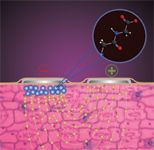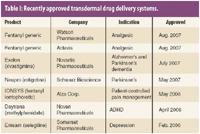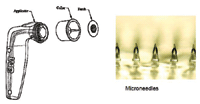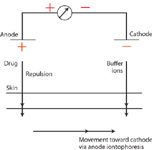Advances in Transdermal Technologies
Transdermal delivery takes up once-forbidden compounds, reviving markets and creating formulation opportunities.
During the past 20 years, the transdermal delivery systems (TDDS) have greatly expanded their role in healthcare, fueled primarily by their advantages over other routes of administration. TDDS avoid the first-pass metabolic effects of the liver, ensure compliance, provide steady sustained release, and reduce pill burden. In addition to the first TDDS products on the market, including estradiol, nicotine, and combination hormone replacement therapies, a range of other products have been approved in only the past two years (see Table I).

ILLUSTRATION: MELISSA MCEVOY. ADAPTED FROM: WWW.TRAVANTIPHARMA.COM/SCIENTIFIC_STUDIES.HTML
Passive delivery
Passive TDDS have been used for decades to successfully deliver small-molecule drugs. Since the first reservoir patch was developed, there have been several advancements to passive-diffusion formulations, most notably the one-layer drug-in-adhesive (DIA) technology (see Figure 1). Unlike the liquid-in-a-pouch reservoir, the DIA matrix is solid and therefore does not have a potential for leakage. Advancements in the DIA technology include the ability to deliver more than one drug in one patch.

Table I: Recently approved transdermal drug delivery systems.
Passive TDDS are applicable for lipophilic, low molecular weight (< 500 Da) molecules or molecules that have fairly low doses. Various combinations of permeation enhancers and other excipients in passive TDDS have been used for molecules with slightly larger molecular weights or higher doses. The type of enhancer depends on its compatibility with the drug and its permeability, and the rate of diffusion depends on the skin and TDDS membranes. Even with the use of enhancers, however, there is a limited number of drugs for which the passive delivery method can be used.

Figure 1: Drug in reservoir and drug in adhesive designs. (FIGURE: ADHESIVES RESEARCH)
Nonetheless, a passive delivery system generally is preferred over an active system because it is more marketable, less expensive to manufacture, and it does not involve a third-party company for the electronics or other device components. In addition, some patients are uneasy about having active delivery TDDS on their skin for any period of time.
Active delivery
The transdermal market is progressing toward active methods of drug delivery. "The expansion of this market includes the incorporation of technologies that address the limitation of the molecule size as well as the desire to enhance dosing accuracy and control. Research in these areas is increasing rapidly," says Richard Sitz, technical manager, Transdermal Drug Delivery, 3M Drug Delivery Systems Division (St. Paul, MN).
For example, 3M developed a "Microstructured Transdermal System" (MTS), which is a microneedle system for transcutaneous or intradermal drug delivery (see Figure 2). "MTS bypasses the barrier properties of the stratum corneum and provides a means to deliver various molecules such as vaccines or macromolecules, that ordinarily would not penetrate the skin," says Sitz.

Figure 2: Microneedle system. (FIGURE: 3M)
Other TDDS use an energy source such as electricity (iontophoresis) or heat to enhance permeation. Although there are several heat-assisted systems in development, not one has yet been approved. "The advances in active delivery technologies are very exciting. Once these technologies pass regulatory scrutiny, more transdermal medications will be available for patients," predicts Carolyn Myers, president of Mylan Technologies (Burlington, VT). Recent approvals in TDDS include an iontophoretic unit (see Table I).
"If the drug requires a long time to permeate the skin, then the potential advantages of using an active system is to get a rapid onset of action," says Rashmi Upasani, research scientist, at Cirrus Pharmaceuticals (RTP, NC). Other advantages include the ability to achieve pulsatile or patient-controlled delivery and the ability to reduce inter-individual variability in drug delivery. (Passive permeation depends on the thickness of the skin and type, but iontophoresis depends on how much electric potential is used across the skin, so the variability is comparatively less than with passive patches).

Gaining approval
The structure of an electrical iontophoresis TDDS includes a DC power source and an adhesive electrode with a reservoir on the dermal side. An electric current is passed through the drug solution, which drives the drug into the skin. Iontophoresis systems take advantage of the fact that like charges repel. Therefore, a negatively-charged drug or compound is delivered using the cathode, and positively-charged drugs are delivered using the anode. It is also believed that drug delivery is enhanced not only by these electro-repulsive forces but also by the opening of transdermal pathways such as pores and sweat glands by the application of the current. Battery-powered iontophoresis TDDS (see Figure 3) require the drug to be placed on only one side and others allow placement on either the positive or negative side. In anode iontophoresis, the drug has a positive charge. When placed near the anode, electro-repulsion pushes it through the skin.

Figure 3: Schematic of iontophoresis delivery. (FIGURE ADAPTED FROM Y. WANG ET AL, EUR. J. PHARM. SCI., 2005)
The history of using electricity to transdermally deliver drugs dates back to the late 1800s, with the first demonstration of the delivery of strichnine to rabbits. The implementation as a drug delivery system was impractical, however, until the past 20 years. Drug delivery by electrical stimulation now has a wide application in the physical therapy market to treat injuries such as tendonitis as well as localized inflammation. One such drug is dexamethasone. "The more you get away from systemic delivery of these drugs, the better off you're going to be," says Jim Pomonis, director of medical affairs, at Empi (St. Paul, MN).
Iontophoretic delivery systems present more complex challenges than passive systems. For iontophoresis systems in which the drug is dissolved in water before it is applied to the reservoir on the electrode, there is an added concern. "Whereas for passive transdermal systems you worry about adhesion, skin irritation, and allergic reactions to the gel, we have the additional issues that as you pass current through water you're going to get hydrolysis, which can change the pH level," says Pomonis. Empi developed buffered electrode systems to prevent the change in pH. Hydrolysis is still allowed to occur, but it is buffered. Iomed (Salt Lake City, UT) took a different approach to this problem and developed a silver-silver-chloride electrode that prevents hydrolysis and prevents the pH from changing.
Formulation. The amount of drug that can be loaded into a device and the amount that can actually cross the skin can be two different values. The volume that can be loaded into the device depends on the device and the technology. The amount that traverses the skin depends on the formulation and the drug.

Defining the dose
"We try to select molecules that are already charged by their nature," says Upasani. "It is possible to transport neutral molecules with electro-osmosis and iontophoresis. If the molecule is charged, however, there are two forces acting on the molecule, electrorepulsion and electro-osmosis, which helps the drug pass into the skin."
As in passive TDDS, molecular weight is the major issue. Although large molecules can be delivered with iontophoresis, there are limitations with larger proteins. For example, there are conflicting reports on the iontophoretic delivery of insulin. "Several research groups have demonstrated delivery, and there are groups that have not achieved delivery of insulin with iontophoresis," says Upasani.
"From an engineering standpoint we use 10 kDa as a molecular weight guideline," says Thu-Ha Duncan, director of research and development at Empi. "Anything over that, we'd have to do some testing and really look at the molecular chain to see whether we can do it."
With the proper ratio, it may be possible to deliver two actives in one transdermal, but it is not easy. "The main challenge with the iontophoretic system is the competition between the drug and the excipients such as the buffers with the drug. The system depends on the relative size and charge of the molecules, and there would definitely be a preference for one passing through than the other," says Upasani.
Challenges
"There's a fine art to developing a transdermal system," says Myers. She outlines three key objectives for designing a TDDS:
- Deliver the appropriate dose throughout the dosing interval
- Ensure the system is safe, including that it adheres effectively and is not irritating
- Aim to develop a product that is elegant, that the consumer will accept and can afford.
"The challenges are working through the various steps to achieve these three key objectives," says Myers.
In some cases there is a pH change across the skin layers, and the drug may not go all the way through because the charge on the molecule of interest changes as it travels through the skin. Extensive preformulation must be conducted to understand the physical and chemical characteristics of the drug.
To address these challenges, Sitz emphasizes the importance of a solid working partnership between the transdermal researchers and manufacturers."The average time for the development of a pharmaceutical product is roughly five to seven years; therefore, the health of the entire collaboration is critical," he said. "Having a strong communication channel is one of the most important tools for successfully initiating and managing the collaboration between all disciplines. Our research findings have proven that the most important attributes considered during a partnership are performance, commitment, and communication."
Advanced adhesives
The increasing scope of the transdermal delivery market, including the delivery of larger molecules such as proteins, has raised the bar in innovative TDDS components. TDDS that are worn for longer periods require adhesives that offer a breathable environment so that moisture can be removed from the skin surface. "Customers are requesting adhesives for active delivery applications that range in wear times from minutes to a week or longer. We formulate adhesives that will bond over these wear periods in various dermatological environments," says Scott Knorr, pharmaceutical business manager, Adhesives Research, Pharmaceutical Applications (Glen Rock, PA).
Some adhesives used in passive TDDS can also be used in active systems. Adhesives Research, for example, develops and manufactures acrylic, polyisobutylene, silicone, and hybrid (multichemistry) coatings for both formats. According to Knorr, additional considerations when designing an adhesive for active TDDS include the following:
- Wear considerations and bonding: An adhesive used in an active TDDS may be required to bond to unique surface energies such as the housing of a device over short-term (removable) or long-term (permanent) periods. In addition, skin-contact adhesives must often be designed to support the weight of the device and may encounter unique environmental conditions.
- Compatibility and stability: Pressure-sensitive adhesives used in active TDDS must not only be compatible with the active pharmaceutical ingredient (API) and formulation excipients, but also the device itself, which may include sensitive electronics.
- Multifunctionality: As the manufacture of active TDDS increases in complexity (relative to their passive transdermal counterparts), customers are asking adhesives to do more beyond simply bonding such as promoting electrical and ionic conductivity.
Future prospects
There is much to look forward to for both passive and active transdermal drug delivery systems. "There is a huge opportunity for active diffusion as many products currently on the market are very difficult to deliver through passive diffusion. However, the passive diffusion market has certainly not been exhausted," says Myers. "Critical to the success of active diffusion is to develop products that are cost effective to the consumer."
Cirrus is exploring the use of nanotechnology in various areas of drug delivery and is capable of extending the technology to TDDS to improve skin permeation. Scientists at Adhesives Research are working on the development of a porous adhesive platform with tailorable pore sizes and densities that create pathways through which a drug may flow to the skin or moisture and other materials may be removed from the surface of the skin. The company also is developing coatings with molecularly imprinted polymers (MIPs). "These MIPs are synthesized with the unique chemical and physical 'imprint' of a target molecule. MIPs can be formulated into an adhesive coating and used to capture or release the target molecule in a diagnostic or drug delivery application," says Knorr.
"Where I see the technology going and where I see the market hasn't really expanded is partnerships with a pharmaceutical company to preload the devices with the drugs," says Duncan.
"We are at the forefront of what we can do," adds Pomonis. "We are clearly able to, with advances in microprocessors and electronics and circuitry, come up with very complex dosing regiments. We are understanding more and more about skin resistance and how that affects drug delivery. There are drugs sitting in the chemical libraries of pharmaceutical companies that have not made it through the development process either because of challenges in formulation or more likely worries about systemic side effects that may be addressed with advanced transdermal systems. Truly there should be a tremendous opportunity in the near future for those collaborations."

Drug Solutions Podcast: A Closer Look at mRNA in Oncology and Vaccines
April 30th 2024In this episode fo the Drug Solutions Podcast, etherna’s vice-president of Technology and Innovation, Stefaan De Koker, discusses the merits and challenges of using mRNA as the foundation for therapeutics in oncology as well as for vaccines.